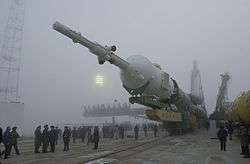Soyuz TM-31
| Operator | Rosaviakosmos | ||||
|---|---|---|---|---|---|
| COSPAR ID | 2000-070A | ||||
| Mission duration | 186 days, 21 hours, 48 minutes, 41 seconds | ||||
| Orbits completed | ~3,040 | ||||
| Spacecraft properties | |||||
| Spacecraft type | Soyuz-TM | ||||
| Manufacturer | RKK Energia | ||||
| Crew | |||||
| Crew size | 3 | ||||
| Launching |
Yuri Gidzenko Sergei Krikalev William Shepherd | ||||
| Landing |
Talgat Musabayev Yuri Baturin Dennis Tito | ||||
| Callsign | Uran | ||||
| Start of mission | |||||
| Launch date | October 31, 2000, 07:52:47 UTC | ||||
| Rocket | Soyuz-U | ||||
| End of mission | |||||
| Landing date | May 6, 2001, 05:41:28 UTC | ||||
| Landing site | 90 kilometres (56 mi) NE of Arkalyk | ||||
| Orbital parameters | |||||
| Reference system | Geocentric | ||||
| Regime | Low Earth | ||||
| Perigee | 190 kilometres (120 mi) | ||||
| Apogee | 249 kilometres (155 mi) | ||||
| Inclination | 51.6 degrees | ||||
| Period | 88.6 minutes | ||||
| Docking with ISS | |||||

| |||||

Soyuz TM-31 was the first Soyuz spacecraft to dock with the International Space Station (ISS).[1] This Soyuz-TM spacecraft carried the members of Expedition 1, the first long-duration ISS crew. It was launched from Russia at 07:52 UT on October 31, 2000 by a Soyuz-U rocket.
The crew consisted of Russian cosmonauts Yuri Gidzenko and Sergei Krikalev, and American William Shepherd. Gidzenko was Commander of the flight up, but once aboard the station, Shepherd became Commander of the long-duration mission Expedition 1.[2]
The spacecraft served as the crew's lifeboat while docked to the ISS. The Expedition 1 crew were returned to Earth via a Space Shuttle during STS-102 in March 2001, and the Soyuz TM-31 spacecraft stayed with the station for part of Expedition 2. In April 2001 another spacecraft, Soyuz TM-32, arrived at the station, and took over responsibilities as the station's lifeboat. The crew launched by Soyuz TM-32, which included the first paying space tourist Dennis Tito, were returned to Earth in May aboard Soyuz TM-31. The visiting mission of which Tito was apart is sometimes referred to as ISS EP-1.
Crew
| Position | Launching crew | Landing crew |
|---|---|---|
| Commander | Expedition 1 Second spaceflight |
ISS EP-1 Third and last spaceflight |
| Flight Engineer | Expedition 1 Fifth spaceflight |
ISS EP-1 Second and last spaceflight |
| Flight Engineer/Spaceflight Participant | Expedition 1 Fourth and last spaceflight |
ISS EP-1 Only spaceflight Tourist |
Docking with ISS
- Docked to ISS: November 2, 2000, 09:21 UTC (to aft port of Zvezda)
- Undocked from ISS: February 24, 2001, 10:06 UTC (from aft port of Zvezda)
- Docked to ISS: February 24, 2001, 10:37 UTC (to nadir port of Zarya)
- Undocked from ISS: April 18, 2001, 12:40 UTC (from nadir port of Zarya)
- Docked to ISS: April 18, 2001, 13:01 UTC (to aft port of Zvezda)
- Undocked from ISS: May 6, 2001, 02:21 UTC (from aft port of Zvezda)
Mission highlights
The Soyuz carried a crew of three to dock it with the Zvezda module of the International Space Station (ISS) at about 09:21 UT on November 2. The Progress M1-3 cargo craft that was docked with Zvezda was released to make way for the Soyuz. The crew of two Russian and one American spent over three months on the ISS, and returned to Earth in an American shuttle (STS-102) in February 2001. In the initial days, the crew brought a variety of life support systems on-line, and created a laptop computer network that helped run all systems in the ISS. The remaining months were allotted for exercise and space endurance practice. The crew was first group of a planned decade-long "permanent inhabitation" of the ISS.
References
- ↑ "Soyuz ISS Missions" (PDF). NASA.
- ↑ "ISS: 10 Years of Human Space Mission". Russian Federal Space Agency.

